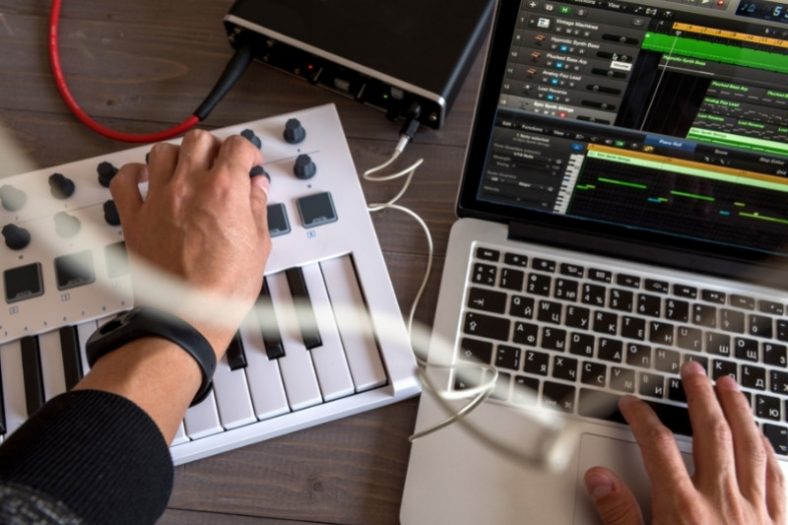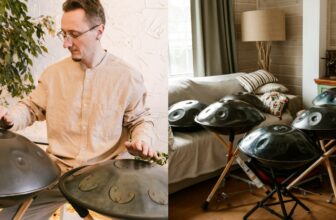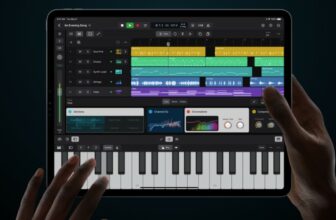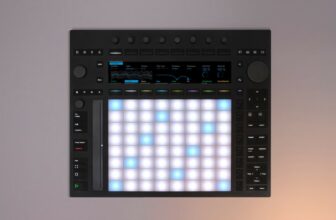15 Tips to Make Software Drums Sound Real (MIDI and Sampled Drums)

Contents
- 1. Add velocity and timing alterations
- 2. Play with ghost notes and grooves
- 3. Sing your beat before programming it
- 4. Consider the limitations of a real drummer
- 5. Use a top-notch drum library
- 6. Increase realism with a two-hand approach
- 7. Add organic background sounds
- 8. Maximize loop length
- 9. Don’t quantize percussion instruments
- 10. Place your drum track inside a room
- 11. Add sidechain gate
- 12. Create tension before the ‘one‘
- 13. Add reverses for better-sounding snares
- 14. Play with tuplets
- 15. Study real grooves
- Summary
1. Add velocity and timing alterations
Velocity refers to the energy applied to each beat in a drum loop (i.e., its volume) and can be easily edited in most DAWs. In Ableton Live, for instance, you can change a beat’s velocity by tweaking the red MIDI Velocity Editor fader at the bottom of your MIDI Note Editor.
Slight changes in velocity can turn a boring drum loop into a dynamic, human-like rhythm that simulates the behavior of a real drummer. Unlike your laptop, a real drummer will not always play the snare drum at 100% of the volume. Making one snare slightly louder than the other is a good, quick way of humanizing a drum loop that feels too computerized.
The same applies to timing. Making slight alterations in the tempo of your beats can be a good way of emulating the unavoidable tiny mistakes committed by real-life drummers. We’re not talking about utterly ruining the tempo of your song: timing changes need to be applied with care, and a few milliseconds should be enough to get rid of that annoying, overly-quantized feel.
2. Play with ghost notes and grooves
Real-life drummers play instinctively: they follow the motion of their bodies and express themselves according to their gut. But how can a music producer with no ability to play the drums recreate the natural expressiveness of a real-life drummer? Well, ghost notes and grooves can be a big help.
Ghost notes are beats that are being played at such low velocity that can barely cut through the mix. While virtually inaudible, these ghost notes occur in every real drum recording session and should be replicated inside your DAW. To do so, you can manually insert ghost notes into a drum loop or go for a groove preset.
Not all DAWs offer MIDI groove presets, but the ones that do are making your mechanized beats a favor. Ableton Live has a great selection of grooves that can be applied to any MIDI drum loop.
To use Ableton Live’s grooves, open the Groove Pool and right-click to ‘Browse Groove Library.’ To insert a groove into a MIDI loop, drag your preferred .agr file to the MIDI note editor. Ableton Live’s grooves will instantly unquantize your MIDI drum loop, recreating the natural expressiveness of a real drummer.
3. Sing your beat before programming it
Most drummers will start by “singing” the rhythm they’re imagining in their heads before playing it. This responsible approach to music composition can be recreated inside your DAW. All you need to do is “sing” a beat inside your head before starting to program it.
Many music producers still make beats by trusting their DAWs grids first and their musical instincts second. To make sure you’re not going against your instincts while programming a beat, start by recording it using your voice. Never mind your beatboxing skills: the goal is to have a simple audio reference of the beat you want to make before starting to work on it.
Your songs will sound a lot more natural and put-together if your drums’ are based on a catchy, “singable” rhythm.
4. Consider the limitations of a real drummer
Overdoing it is one of the most common mistakes in programming a beat. Because you don’t have to sweat for the beat to be played, you may feel tempted to add sound after sound and create an increasingly complex beat cluster. To avoid this, keep in mind that a real drummer would never be able to play more than four sounds at a time (one for each limb).
By considering the limitations of a real drummer during your beat-composition process, you can say goodbye to cluttered, unrealistic beats only a machine would be able to play.
5. Use a top-notch drum library
Emulating the sound of a real acoustic drum is even harder than creating human-like electronic beats. For one, finding the right samples can be a challenge.
Luckily, there are some great VSTs specially designed for producers trying to recreate their favorite rock and metal beats inside their DAWs. Superior Drummer 3 and XLN Audio Addictive Drums 2 are two of the best options out there. Steven Slate Drums 5 and Toontrack EZDrummer 2 are also favorites among rock musicians.
6. Increase realism with a two-hand approach
Imagine you’re trying to create a hi-hat pattern or a tom roll inside your DAW. To do so, you’d probably start by selecting a nice-sounding sample and inserting it into the grid. The problem is that the pattern will most likely sound mechanized. This will happen because you’re not considering the two-hand factor that comes into play when real drummers perform fast patterns—like paradiddles.
To pretend that there’s a right and left hand playing a fast tom roll inside your computer, duplicate the tom sample you’re using and create a right-hand and left-hand tom by making slight alterations to the sound. I like to do it by pitch-shifting one of the sounds a few cents up or down. Adding a small panning distance (without going full stereo) can also be effective.
7. Add organic background sounds
For a more creative tip on how to come up with dynamic beats, experiment with adding discreet organic background sounds to your drum loops. If you’re working inside Ableton Live, you can achieve this with a few household objects, a microphone, and Simpler.
Start by recording an audio file of as many percussive sounds as you’d like, from shakers and maracas to drinking cups and cooking pans. Then, drag the audio file to Simpler’s Sample Display and select the option ‘Slice.’ This action will divide the audio into many playable MIDI notes, sliced according to the transients in the file.
This means you’ll have a wide selection of short noises that can be quickly played over a drum loop to create a sense of depth and sonic richness. For increased randomness, place a Random and Note Echo MIDI effect before the Simpler.
8. Maximize loop length
No matter how bored a real drummer is, he or she will never play the same 1-bar rhythm over and over during a song. So, why should you build entire sections of your tune on top of an overly-repetitive 1-bar loop?
If you want to improve the realism of your programmed drums, work with loops at least 4-bars long. This doesn’t mean you need to come up with a groove that’s interchanging at every step of the way. You can use the same basic rhythm for each bar of the loop, but add small changes to the groove to make it more interesting.
This can be as easy as removing the kick from the second bar, placing the snare a bit later in the third bar, or adding a snare roll in the final section of the loop.
9. Don’t quantize percussion instruments
Off-beat kick and snare sounds can hurt a track by making it feel less incoherent. But off-beat percussion instruments have the opposite effect: if mixed right with the main beat, they can turn a computerized drum loop into a lively festival of rhythm.
Two of the producers behind the Latin-pop hit “Despacito” tackled this technique in the below video. They wanted their beat to feel more pop (i.e., human) and less electronic, so what have they decided to do? To record a series of percussion instruments and place them on top of the main beat without any quantization.
In case you cannot record real percussion instruments, you can achieve the same effect by playing percussion sounds on a MIDI controller.
10. Place your drum track inside a room
While there are many ways of recording a live band, audio engineers tend to do so by placing all the musicians inside a room at the same time. For this reason, the sound produced by one musician may spill into the track of another—like when you hear the drums in the background of a bass guitar recording.
To make your drum loop sound more real in the context of a song, you can recreate this phenomenon inside your DAW by placing the drums in a virtual “room.”
You can do so by sending your drums to a Return channel with reverb. Ideally, the reverb should have an aggressive low-pass filter and be 100% wet. The goal is to emulate the feeling of real-life drums, played in a real-life room, next to other real-life instruments.
If you’re working on an acoustic song with a set of programmed drums, you will be surprised by how much of an impact this technique can have on the overall feel of your mix.
11. Add sidechain gate
Creating subtle changes in the sounds of a drum loop is a nice way of humanizing rhythmic patterns. However, this process can be tedious, especially if you’re working with audio-effect automation and pitch modulation.
An easier way to do this is by adding a Gate to the drum loop and sidechaining it to a track that contains several diverse sounds. In my experience, field recordings (such as the sounds of the woods or the beach) make for the perfect sample pool.
The sidechain Gate will cause the field-recordings track to only play whenever a transient hits, meaning that each sample in your drum loop will sound slightly different from the other.
12. Create tension before the ‘one‘
The ‘one’ is the first beat of any drum loop, the moment in which a new measure in the song is starting. In my early days as a producer, I understood the importance of starting a beat with a strong one (like a punchy drum kick, for instance). However, I failed to realize that the start of a beat is only as strong as the tension created right before it hits.
If you want your drum loop to start with impact, you need to create tension before it hits. You can do this by adding a drum roll to the final bar of your drum loop, generating the necessary power for your first beat to punch through the mix.
13. Add reverses for better-sounding snares
Repetitive snares are great for maintaining cohesion in a song, but they can sound unenergetic at times. A great way to avoid this is by adding reverses right before the snare hits. This simple technique will turn any discreet snare into a more powerful version of itself.
The easiest way to do this is by duplicating the snare, adding reverb, and recording the reverberated snare. Once you have it in a consolidated audio file, you can reverse it to create a short “swoosh” sound effect. Add it before the snare, and you will notice that your loop will sound more modern and dynamic. You may have to lower the volume of the reversed snare for the actual snare to pop out.
14. Play with tuplets
One of the best ways to avoid working inside the grid while maintaining a structured tempo reference is to work with tuplets.
Tuplets can be defined as divisions of a beat that fall out of the four-by-four standard. If you’re using a Triplet grid, for instance, every beat of the grid will be divided into three equal sections. Many DAWs feature a Triplet grid option, but how can you take tuplets one step forward?
Imagine you want to create an interesting hi-hat pattern using quintuplets in Ableton Live. The problem is that Ableton Live will not allow you to automatically divide the beats in the grid into five even spaces. Luckily, there’s an easy way around this.
Open your MIDI note editor, right-click to fix the grid into 1/4, and write six MIDI notes into the grid. Then, press Ctrl/Cmd+A to select all the notes. You will notice that a MIDI Stretch Marker will appear at the start of the sixth note. Select that marker and drag it to the end of the first bar. The result? The first bar will now be divided into five even spaces—a perfect quintuplet. You can use the same technique to generate as many tuplets as you want.
In case you’re confused, this one-minute video may help to clarify things.
15. Study real grooves
Programming MIDI drums is a lot like composing drums on paper, so it may come in handy to study drum notation and learn how sheet music works for drum grooves. This will help you a lot in composing drums because it gives you access to millions of real-life drum grooves that you can use as a reference.
Learning about drums to program better drums sounds like a given, but I cannot stress enough how useful it is for an electronic producer to know how to read a piece of sheet music, especially in the context of drums.
Summary
In the end, making software drums sound real is making software drums sound good!
It’s not just about producing realistic acoustic drums inside your DAW but making electronic beats as dynamic and energetic as the beats played by real-life drummers.
To take your drum loops to the next level, avoid being overly repetitive, try to include as much sonic variety as possible, and try to come up with grooves that feel catchy and natural. The tips listed above will help you not only to create realistic drums but also to improve your overall approach to rhythm as a music producer.





